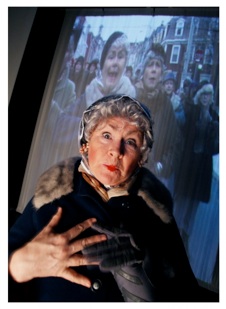Reviews 2013






✭✭✭✩✩
by Mary Walsh, directed by Andy Jones & Mary Walsh
Mirvish Productions, Panasonic Theatre, Toronto
March 5-24, 2013
“Marg Drowns Out Mary”
Mary Walsh is one of Canada’s national treasures. She not only a fine comic actor but is a fearless satirist who can skewer more kabobs of pomposity with a single jab than anyone else in the country. These two sides of her abilities are on display in her solo show Dancing with Rage now playing as part of the inaugural Off-Mirvish season. There is, however, a third side to Walsh – that of a serious actor – whom some may have seen before she joined This Hour Has 22 Minutes. I still remember her great performance as Josie in O’Neill’s Moon for the Misbegotten opposite Colm Feore at the Grand Theatre in 1993. This side is also on display in Dancing with Rage but Walsh and co-director Andy Jones have unfortunately decided to drown it out with a hodgepodge of comic turns from her well-known characters from 22 Minutes.
The show begins as Walsh enters from the back as old Miss Eulalia decrying all the construction in Toronto and hoping she’d make it to the Panasonic Theatre before David Mirvish decides to turn it into a condo. Zingers flying, she makes her way to the stage and begins to undress, revealing a nightgown beneath her sensible skirt and jacket. At this point Walsh, now in her own voice, begins to read from what is nominally an oversized children’s book called The Little Girl Who Lived Next Door to Her Family. The story tells of a little girl, unloved by her mother, brothers and sisters, who is raised by her maiden aunt and bachelor uncle who live next door. It seems clear that this Walsh’s own story and we would like to know much more about it, filled as it is with humour but also real pain. Yet, although Walsh periodically returns to read more from the book, the story of the book never connects to the rest of the action. We think at the very least that the story will explain how this early sense of alienation led Walsh to become an actor and comedienne – but that never happens.
Instead, Walsh undresses to her undies and still in her own voice launches into a hilarious discussion of women’s dislike of their bodies, using her own as an example, and a scorching critique of so-called third-wave feminism. Having shown what a sensitive actor she is in reading her own story and what a satirist she is in her own right, without the use of her 22 Minutes characters, it’s a bit disappointing that she then changes in front of us into her outfit as one of those very characters – Marg Delahunty.
This change marks the actual beginning of the flimsy plot that is meant as a kind of clothesline where Walsh can hang her television characters for show. In this plot, which has nothing to do with The Little Girl story, Marg is told by her ophthalmologist that she has macular degeneration and will eventually go blind. (Walsh, in fact, has this condition and served as a spokesperson for the CNIB.) This news leads Marg to seek out the child her family forced her to give up for adoption 44 years ago – the child a product of a teenaged sexual encounter at Expo 67.
During the course of Marg’s quest we meet her daughter with the perpetual cold who pronounces “Mom” as “Bob”; Dakey Dunn, the macho cab driver; Connie Bloor, the dim donut-munching denizen of “Joe Orton’s” with the snorting laugh; along with new characters like Marg’s demented mother living in a nursing home run by a nun with bad dentures played by a hand-puppet. While this plot gives Walsh the chance to satirize the circularity of voicemail systems and the officiousness of administrators of all kinds, its conclusion is a letdown and is left undeveloped.

At the end of the show Walsh has all her various characters gather together and thus cannot spend time changing costumes and makeup to transform herself from one to the other. She does this through voice and gesture alone as indeed she could have done from the beginning as Rod Beattie does in the Wingfield plays. This only points out the central problem of the play. Walsh is caught among several competing desires – wanting to give her audience a chance to see their favourite television characters live on stage; satirizing the vain, pompous and trendy of the day; telling a humorous story about Marg Delahunty; and telling a more serious story about herself. While the audience is clearly delighted to see Walsh’s characters in person, the most compelling portion of the play is Walsh’s own story which she presents as oddly disconnected from everything else.
People who merely want to see the great Mary Walsh on stage will not be disappointed. People who want to see an effective solo show, however, will wish that Walsh had focussed the show on her own life and the origins of her impulse to satirize and had subsumed her television characters and political antics to that story.
©Christopher Hoile
Note: This review is a Stage Door exclusive.
Photos: (from top) Mary Walsh as Marg Warrior Princess; Mary Walsh as Miss Eulalia. ©2012 The Collection Agency.
For tickets, visit www.mirvish.com.
2013-03-13



Dancing with Rage





